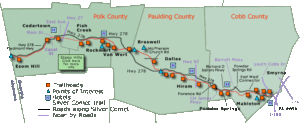
It’s a future I won’t live to see. But I remember what the great park designer Frederick Law Olmsted said when asked why he was building things that wouldn’t be finished until long after he was gone. “We did this for you,” he said.
Another example, closer to home, is of my late father in law, Bennie Steinhauser, a lifelong educator who planted trees near his ranch cottage when he was 85. He was my definition of an optimist. We should all be more optimistic.
Here’s my modest proposal. It’s a process, the specifics left to others. I call it the Five Mile Ring.
Start by taking advantage of suburban egos. Around Atlanta, as with most big cities, there are leaders who want to steal the center’s thunder. They have their own business recruitment groups, even their own tourist bureaus. (See DeKalb County!)
Each suburb wants its own downtown. This may be built around a courthouse, a city hall, even a shopping district. We should encourage it. Encourage the construction of tall suburban buildings, first offices, then residences. Encourage suburban traffic jams, going into and out of these new centers, far from where people talk about mass transit.
It’s at this point that suburban leaders will see the need to support e-transport to their new centers. Paths for e-transport are the only possible solution. Draw a ring 5 miles from each center, and you have a 20 minute bike ride with enough density to support the path. There’s already a movement like this, encouraging “bike buses” for schools. Build around that.
What Comes Next

Once you have e-transport trails to the new suburban centers, the next step is to connect the centers. The networks overlap if suburbs are within 10 miles of each other. People will start biking between Decatur and Chamblee, or between Marietta and Dunwoody, if they have safe paths on which to do it.
Very soon suburbs will reach out to one another, building fast bike lanes that act as tourist attractions, like Atlanta’s Silver Comet Trail. There is room in the exurbs for spectacular trails to be built, enhancing property values all along them, as the Silver Comet has created density west of Atlanta in places like Hiram and Dallas.
I don’t expect to see the end of this process. It’s a 20 year vision. But so was the Atlanta Beltline.










